With age, the regeneration of collagen and elastin fibers slows down, the skin stretches, and the oval becomes unclear. When cosmetics are no longer effective, plastic surgery comes to the rescue, but it is not for everyone. In this situation, it is worth paying attention to an alternative - a facelift using polymer threads. The Aptos method is relatively new and has both negative and positive sides. To make an informed decision, you should better study the technology of the process, the nuances of rehabilitation, and find out the opinions of former patients.
What is a facelift with Aptos threads, features and effectiveness of the procedure
Unlike traditional surgical plastic surgery, a facelift using Aptos threads is virtually bloodless. It does not require deep penetration into the tissue, does not leave scars, and there are few contraindications. After hemming the threads, the aging of the skin is stopped and wrinkles are smoothed out. The improvement in facial appearance is noticeable immediately after the manipulations. The final result, as evidenced by reviews, appears after 3-4 weeks, and it lasts for 2-5 years.
The purpose of a thread facelift using the Aptos method is to create a kind of framework for soft tissues. They gradually move and are fixed in the right place thanks to notches on the threads. Due to the different directions of the notches, the tissues do not move and remain in a taut position for a long time. Different types of Aptos organic threads differ in design and properties. The specialist selects the right material depending on the patient’s age, the severity of wrinkles and other individual characteristics.
Types of threads for lifting
1. Non-absorbable threads. They are made of polypropylene, which has been used for more than half a century in classical surgery for suturing. The material is harmless to the body, takes root well, and is hypoallergenic. The frame made of polypropylene threads is durable, and the aesthetic result is long-lasting (4-5 years).
2. Aptos absorbable threads (Light Lift). This is an original development by the authors of the Aptos method, in which caprolac is taken as a basis. The period of decay and elimination from the body is about a year. In addition to caprolac, the threads contain lactic acid - thanks to it, cell regeneration processes are activated, due to which skin rejuvenation occurs. 1-3 months after the implantation of the threads, the soft tissues begin to grow their own bioframework from the developing connective tissue. It provides lifting until the Aptos threads completely dissolve, on average - 2-3 years.
Light Lift threads are recommended for patients aged 30-35 years: the bioframework prevents ptosis of facial tissues, light lifting, and rejuvenation of facial contours and skin. In the period from 35 to 45 years, a combination of non-absorbable threads (in the area of the chin and cheeks) with caprolac (in the upper and middle parts of the face) is more acceptable. After 50 years, only polypropylene material can maintain the oval of the face.
Indications and contraindications
A face or neck lift using the Aptos method is recommended if you have the following problems:
- the contour of the face was deformed, a double chin formed;
- the skin has lost its natural elasticity and has become uneven;
- the skin sagged in the lower part of the cheeks ("jowls" formed);
- the corners of the lips, eyelids, eyebrows drooped;
- the skin was deformed due to scars;
- congenital or acquired facial asymmetry;
- sharply expressed nasolabial folds or frontal wrinkles;
- degeneration of subcutaneous fat in the anterior neck, moderate sagging of soft tissues.
Despite the fact that the procedure is low-traumatic, it can cause complications, the risk of which is increased by existing contraindications. Thread lifting is not recommended for the following diseases or conditions:
- chronic diseases in the acute stage;
- cardiovascular diseases;
- ARVI and other acute infections;
- pregnancy, breastfeeding;
- inflammation or cancer on the skin of the face;
- tendency to form keloid scars;
- decreased blood clotting;
- the presence of injection implants made of synthetic materials in the area where the threads are installed.
No special preparation is needed. In order not to cause complications in the form of blood loss, a week before the lift, stop taking antiplatelet agents and anticoagulants that thin the blood.
How a facelift is performed, possible complications after the procedure
Aptos thread lifting is performed under local anesthesia. First, the doctor marks the skin with a marker. In order not to get a negative result, it is important to correctly determine the location of the threads. They are not placed in areas of active facial expression, they are not carried out through several zones at once, and they take into account the thickness and texture of the skin. According to the markings, punctures or mini-incisions are made (the second option is intended for non-absorbable threads). The puncture sites are usually hidden in inconspicuous places - behind the ears or under the hair in the temporal part.
Through the holes, blunt needles (cannulas) are inserted into the subcutaneous fat, in which the Aptos reinforcing suture material is fixed. The threads are carefully pulled up, the ends are cut so that the threads are recessed under the skin. The puncture sites are disinfected. Reinforcement of a separate area of the face lasts from 10 to 30 minutes, a facelift in several areas will require from 1.5 to 2 hours.
After installing the Aptos thread frame, the following complications and side effects are possible:
- the threads are exposed - this defect is eliminated by trimming the protruding ends;
- the threads stretch - they will have to be replaced (at least 3 months after the first procedure);
- minor hemorrhages appear - they usually go away on their own within 2-3 days;
- local hematomas occur (often in women who smoke due to the fragility of blood vessels);
- puncture sites become inflamed;
- there is pain and tightness of the skin.
Exposed threads are most often explained by the surgeon’s lack of experience. Stretching of the material may be due to its poor quality, and in some cases, to loss of facial weight. Other problems can be easily avoided or minimized if you take into account the recommendations of specialists regarding the recovery period.
Rehabilitation after lifting Aptos
Studying the negative reviews about thread facelifts, we can come to the conclusion: complications are often associated with the fact that rehabilitation took place with violations of the regime. The entire recovery cycle after implantation of the Aptos material is divided into 3 stages.
1. Acute period (3-5 days). Fixing patches remain on the face, skin folds are very noticeable. It is recommended to maintain a particularly gentle regime: sleep on your back, do not drink hot drinks or food, do not support your head with your hands, refrain from the slightest facial massage, do not open your mouth wide, chew without sudden movements. During this period, there are contraindications to taking a hot shower, visiting a steam room, sauna, swimming pool, or fitness club.
The first day after the procedure, the treatment area is cooled with ice. Punctures are disinfected with a 3% solution of hydrogen peroxide three times a day. Later, external decongestant drugs are used: Traumeel, Heparin, Lyoton, Gepatrombin, Troxevasin. They give good results when hematomas appear.
If rehabilitation at this stage is painful, the use of painkillers (Analgina, Pentalgina, Ketanova) is indicated. Reviews about rehabilitation after threads inform that sometimes the doctor prescribes antibiotics (cephalosporins). They prevent inflammatory processes with reduced immunity, as well as with a large number of implants.
2. Early rehabilitation period (up to 14 days). Fixing patches are removed independently or in the office. The folds gradually straighten out: patient reviews indicate that the pace of this process depends on the age and condition of the skin. To make rehabilitation more intensive, you can use physiotherapy: microcurrents, ultrasound, iontophoresis. Hydromasks with hyaluronic acid and creams with peptides are useful. Contraindications for the acute period remain in force, except for visiting a hot shower. Drinking alcohol is also prohibited for 2 weeks.
3. Late rehabilitation period (from 14 to 28 days). The face takes on a normal appearance, retractions and folds are almost invisible. Physiotherapeutic and cosmetic rehabilitation continues, thanks to which the positive result is consolidated. There are almost no restrictions on lifestyle; only contraindications to thermal procedures, massages and injections in the facial area remain (up to 2 months). At the end of the late period, it is recommended to visit a doctor who, if necessary, corrects residual skin defects.
It should be noted that negative reviews about the Aptos method are sometimes associated with a lack of information about the nuances of the recovery period for different zones.
- Aptos lifting of the cheekbone area. The early stage of rehabilitation lasts up to 1 month. All this time, cheekbones may look unnatural.
- Corners of the mouth. Rehabilitation is fast; minor hemorrhages require special attention.
- “Jaws”, chin. In the acute and early period, retractions and slight asymmetry of the chin or lower cheek area are observed. There is moderate pain behind the ears. In general, recovery has an average duration.
- Neck. Unlike a facelift, in this case rehabilitation lasts more than a month. All this time, “furrows” are noticeable on the neck, and pain behind the ears lasts longer than usual. To disguise temporary cosmetic defects, it is recommended to wear a scarf.
Reviews about lifting using Aptos threads
“When planning a facelift 2 years ago, I studied different options. I decided to try the Aptos method; I didn’t want to go under a scalpel. I was lucky: I ended up with the best specialist, a technology developer. Everything was done professionally, without side effects. Looking at my photos before and after lifting, I am convinced that I really look younger. I try to maintain the effect with the help of peelings.”
“Six months ago I had threads installed for a facelift, now I am very worried about complications: my right cheekbone has a hole, and the left one is raised too high. Plus, I got an infection at the clinic and had to undergo treatment for two months. Now I’m looking for a good specialist to remove the threads and do high-quality facial skin correction.”
“I read negative reviews about Aptos technology and want to share my story. 2.5 years ago I needed a facelift due to severe facial ptosis due to sudden weight loss. I had to pump hyaluronic acid into my cheekbones and fix it with threads. It was painful, one thread was not stretched well (then it was tightened again), the face was distorted, the swelling was severe. Thanks to Lyoton, the swelling went away in a couple of weeks. The asymmetry persisted for 1.5 months. Then everything was restored, the tightening effect became noticeable. The threads have already dissolved, but the result remains.”
“As for Aptos, it seems to me that this technique is still crude. A good specialist installed the threads for me, under the guidance of the developer. The performer was very nervous when he showed my different-cheeked face to the manager. Although everything has been restored, I will not do this experiment again. I heard the opinion of surgeons that plastic surgery is much more reliable, and threads are all temporary until the tissues sag again.”
“I was advised to use Aptos threads to correct sagging eyebrows. The procedure took place two weeks ago, and the results are already here! I can’t help but smile, although the doctor warned me that it’s better to refrain from facial expressions for now. I’m glad that the effect should be even stronger.”
Sooner or later, every person experiences signs of facial skin aging. After thirty years, most women notice the first signs of fading and begin to think about existing rejuvenation methods. Plastic surgery is not affordable for everyone, and there are many contraindications to facelift surgery.
But thanks to the development of modern methods of non-surgical rejuvenation, every woman can afford a young face. Thread reinforcement of the face (Aptos threads) allows you to achieve the desired result without the use of a scalpel and, therefore, without a long rehabilitation period and possible postoperative complications.
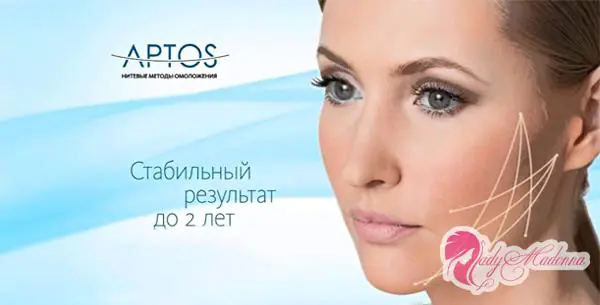
Aptos - a revolution among non-surgical rejuvenation techniques
Thread reinforcement is a modern method of non-surgical face lift using special fixing threads that are inserted under the skin to create a mechanical frame to support the tissue.
The first facelift using threads was invented in 1996 by Russian plastic surgeon Marlen Sulamanidze. He and his team invented and patented the Aptos thread reinforcement procedure. Since then, Aptos products have been used in more than 48 countries. Leading experts in the field of aesthetic medicine recognize that lifting with such threads is an alternative to plastic surgery.
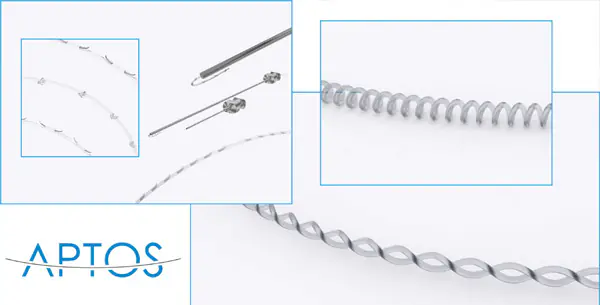
Advantages of facial reinforcement with Aptos threads:
- individual approach to each patient and body area (5 types of threads and more than 50 methods for their installation have been developed, which allows for ideal correction of the required body area);
- natural result - face lifting with Aptos threads is carried out at a depth of 3-5 mm, which eliminates the possibility of damage to nerve endings and blood vessels and does not affect facial expressions;
- complete safety and minimal trauma;
- long lasting effect;
- quick results;
- minimum duration of the procedure;
- short-term rehabilitation period (up to 4 weeks);
- the possibility of combination with other methods of rejuvenation and cosmetic procedures.
Aptos products
Aptos products owe their success to the unique shape and composition of their fibers. Along their entire length, the threads have micro-notches that hold them at the insertion site and prevent migration in the tissues.
All Aptos products are divided into absorbable and non-absorbable threads, which are used depending on the tasks set by the patient. Both materials are absolutely safe for the human body, as they have been used in medical practice for more than 50 years.
Non-absorbable threads Aptos are made from polypropylene. This substance has been successfully used for suturing wounds in surgery for many years.
Absorbable threads Aptos reviews, which speak for themselves, are made from caprolactone. The inventors added lactic acid to the formula of the substance, which, when the threads are absorbed, stimulates the synthesis of its own collagen, which creates an additional framework that keeps the tissues from gravitational ptosis after the Aptos fiber is completely dissolved.
Types of Aptos threads:
Aptos Nano
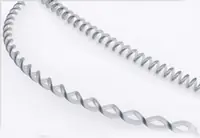
This fiber is almost 2.5 times thinner than any other company product. They are absorbable. Their structure and diameter allow these fibers to be used even for very thin leather.
This series includes two products: Spring (they have the shape of a spring) and Vitis (2 smooth fibers that are woven together).
Aptos Excellence
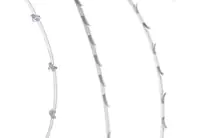
Such threads are used at the first signs of aging on the skin of the face, décolleté and neck, to strengthen the tissues of the arms and hips. Made from caprolactone.
The series includes three products: Visage (has notches that are arranged in a spiral), Elegance (thread with notches) and Body (has notches, designed to reinforce the skin of the body).
Aptos Light Lift
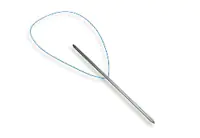
This product is used for mild to moderate signs of skin aging. All threads from the series are absorbable. Recommended for use after 35 years.
The series includes several products: Thread 2 G, Spring, Needle 2 G.
Aptos Surgical
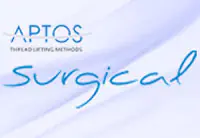
These products are made from materials that do not dissolve. These fibers are used for correction in patients over 45 years of age with deep wrinkles and other pronounced signs of age-related changes. The series includes several products that allow you to choose the material for any occasion.
There is even a line of products that takes into account national types of human appearance.
What is the essence of reinforcement with Aptos threads?
The entire installation of Aptos threads is an outpatient procedure and takes from 15 minutes to 1 hour (depending on the number of threads inserted). Before reinforcement, it is necessary to consult a doctor to collect anamnesis, establish indications and contraindications for the procedure.
Stages of thread insertion:
- first, the doctor marks the skin with a special cosmetic marker (puncture point, thread lines and exit points);
- the procedure is performed in a supine position;
- the doctor administers local anesthesia; if you are allergic to local anesthetics, be sure to inform us about this before the procedure;
- then, according to the markings, the doctor inserts Aptos threads under the skin, which are attached to a special needle or cannula, which facilitates their installation;
- after reaching the end point of fiber establishment, the cannula is removed, the excess thread is cut off;
- all threads are put in place according to the preoperative markings;
- after the procedure, the area is again treated with an antiseptic;
- the injection area is sealed with a band-aid;
- Cold is applied to the place where the fibers are inserted for 20 minutes.
Initial improvements are noticeable immediately after the manipulation, and the final result appears within 2-3 weeks and lasts about 2-5 years.
Rehabilitation period
The entire rehabilitation period after the installation of Aptos threads can be divided into 4 stages.
First stage
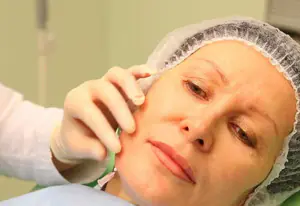
Includes an acute period (up to 3 days after the procedure). It is necessary to refrain from visiting places with elevated temperatures (baths, saunas, hot showers), and do not eat hot food.
A very important point is to be careful with the treated area - do not massage it, do not prop it up with your hands, do not sleep on it, exclude active facial expressions, and do not open your mouth too wide.
Use an elastic bandage while you sleep. Treat the puncture site with an antiseptic 3 times a day, apply cold for 20 minutes several times a day. With the doctor's permission, you can use local remedies that help quickly get rid of small bruises and bruises (heparin ointment, troxevasin, lyoton, hepatrombin). If you are bothered by pain, you can take a painkiller tablet.
Second phase
It is an early rehabilitation period and lasts from 3 days to 2 weeks. At this stage, the protective patches are removed and the patient returns to his normal lifestyle.
The effect of the procedure becomes more noticeable, postoperative folds slowly straighten out. It is still necessary to adhere to the restrictions as in the first stage, with the exception of increased temperature.
You can use cosmetic procedures that are aimed at speedy healing and rehabilitation of the patient (microcurrents, ultrasound, masks and creams based on hyaluronic acid).
Third stage
The late rehabilitation period lasts from 2 to 4 weeks. It is at this stage that the skin acquires its final result. There are no restrictions - you can return to your normal lifestyle. If possible, the cosmetic procedures started at the second stage can be continued.
Fourth stage
The post-procedure period lasts from 6 months to 5 years, depending on the correction area and the individual characteristics of the patient’s skin. After the effect ends, the procedure can be repeated.
Possible complications and side effects
Possible complications after installing Aptos threads include:
- exposure of the end of the thread, which requires trimming;
- subcutaneous hemorrhages;
- infection;
- weakening of the threads, which requires correction no earlier than after 3 months;
- painful sensations.
Proper care of the treated area can significantly improve the overall result after the manipulation, shorten the rehabilitation period and reduce the risk of side effects and complications.
Photos of results
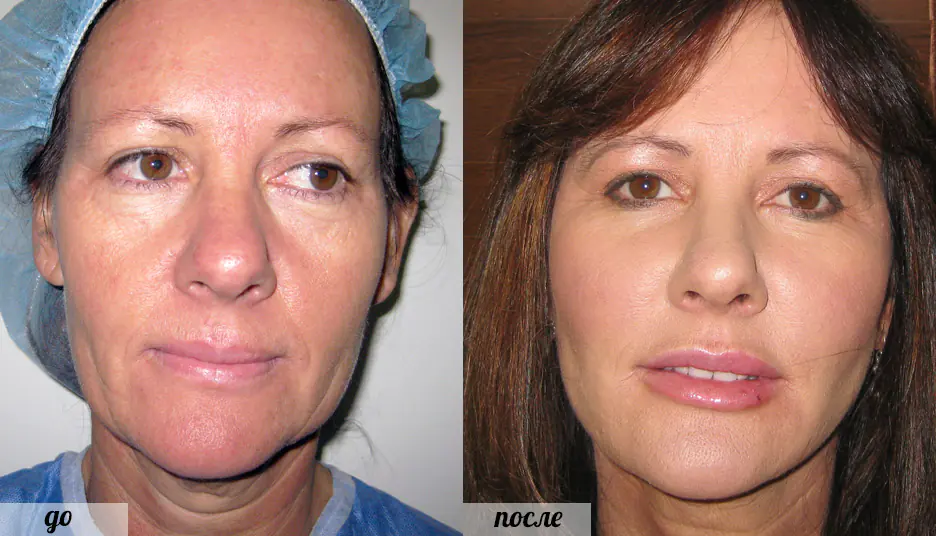
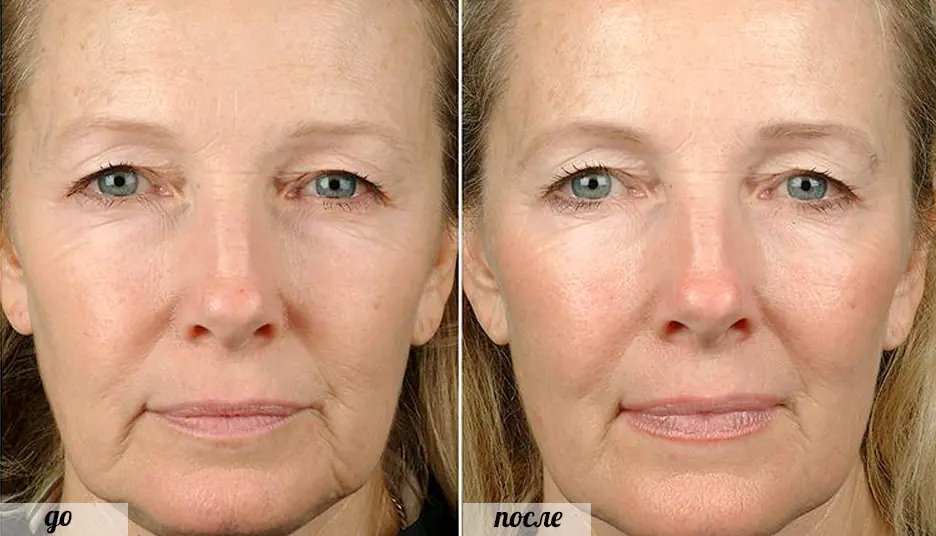
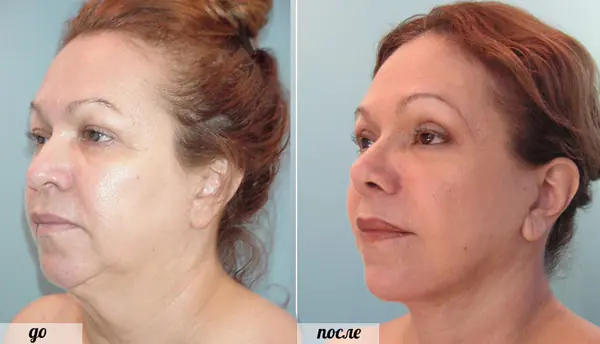
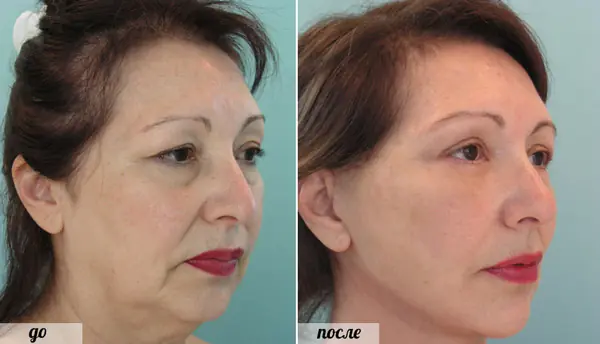
Related posts:
Facelift with Aptos threads: One comment
Good afternoon
Can I have a cheekbone lift with threads? if I have had a mastectomy and breast reconstruction with an implant in the past?
thanks for the answer
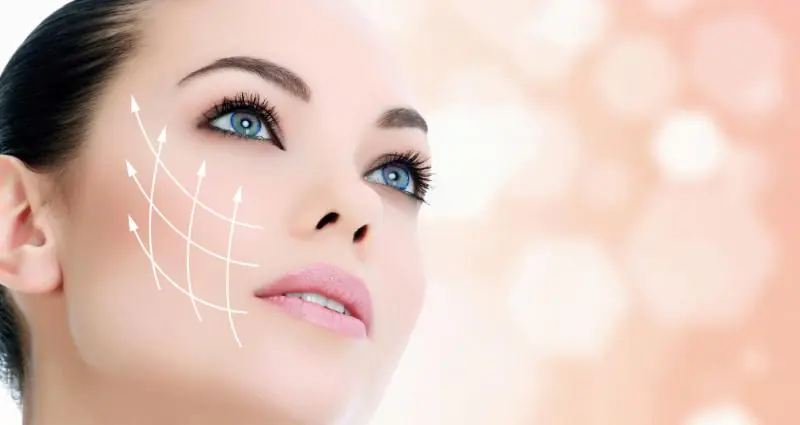
Modern cosmetology helps to restore the attractiveness lost with age and “reset” several years. There are now many methods for this, one of them is the development of the Russian physician M. A. Sulamanidze. These are Aptos implants, which are implanted into soft tissue and form a supporting frame. Today, threads are widely used for face lifting. By the way, the result is evidenced by the name itself, which literally means “against ptosis.”
What are Aptos threads for face lifting?
The first Aptos threads appeared in 1996. Then they were only insoluble. Then, when synthetic materials were discovered in Europe that dissolved and were removed from the body without any health consequences, the range of implants was also expanded in Russia, and soluble threads appeared under the Aptos brand. They solved various aesthetic and age-related problems.
Initially, the threads were smooth - this is understandable, they were used as suture material after operations. Then medical practice showed that it was necessary to work on the shape of the implants, because smooth threads, especially with severe tissue ptosis, had a very short lifespan. The new generation of implants has been improved - in cosmetology they began to introduce threads with notches and fixing cones - they prevented the implant from sliding and moving from the given trajectory. This way, doctors were able to guarantee the patient a much longer-lasting result.
When choosing threads, the severity and localization of wrinkles (or other skin defects), the physiology and genetics of the patient are taken into account.
Indications for use
Modeling the face and body with Aptos threads solves two problems:
- rejuvenation;
- correction of appearance defects.
Implants can be installed on the face, neck, décolleté, arms, chest, stomach, hips and knees - these are the most problematic areas for any woman.
There are no age restrictions for the procedure. Most of the patients are women aged 30 to 45 years. For those who are younger, threads, as a rule, are not yet needed; for those over 50, the doctor may recommend other methods of correction. There are also men among clients; for them (as well as for women, however) the big advantage is that the procedure is non-invasive (compared to surgery), that is, there are no stitches, a long rehabilitation period and scars subsequently reinforced.
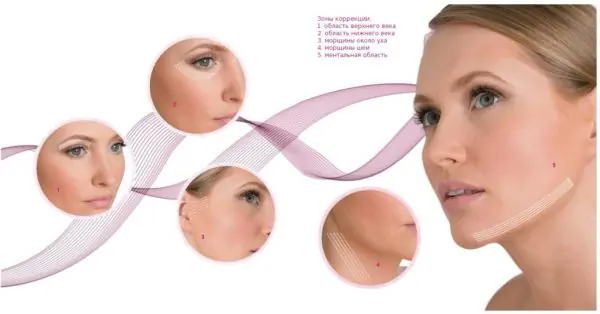
Aptos threads can correct almost any age-related changes and aesthetic problems
Contraindications for bioreinforcement
Bioreinforcement, like any other medical procedure, has a number of contraindications and is not performed on patients:
- with exacerbations of infectious and chronic diseases;
- with skin diseases and inflammation in the area of implantation;
- with oncology;
- with heart and vascular diseases, blood clotting disorders;
- with a tendency to form keloid scars;
- with already installed implants in the correction area.
It is not advisable to carry out the procedure during pregnancy and lactation.

Reinforcement cannot be done in case of certain diseases, skin damage, as well as during pregnancy and lactation
Advantages and disadvantages of thread lifting - table
| + | — |
|
|
Reinforcement with Aptos threads has exactly the same pros and cons as the procedure with any other threads. The materials used for their manufacture are the same as those used by all modern manufacturers - polypropylene for non-absorbable threads, caprolactone and polylactic acid for bio- or absorbable implants. Almost all manufacturers now also work with notches. So Aptos is chosen, rather, for other reasons: if the specialist the patient wants to see (and most often they go to the recommended specialist, and not to any clinic) works with these threads, and if the implants are affordable. The cost of reinforcement consists of the number of installed threads - they are estimated individually. The difference in price, by the way, is significant: if Aptos (1 piece) costs 1400–2500 rubles, then foreign analogues are 2–5 times more expensive. So, Tissulift threads will cost 5,000 rubles. for 1 piece, Silhouette Lift - up to 8000 rub. for 1 piece, and Silhouette Soft - up to 15,000 rubles. for 1 piece The result is approximately the same: physiology and genetics take their toll with age, muscles weaken, tissues sag, and any, even the strongest, frame made of threads will not retain its shape for longer than 5 years.
Aptos thread types
Today, several types of implants are produced under the Aptos TM:
- Excellence biothreads with notches made from a copolymer of L-lactide with ε-caprolactone help remove early signs of aging - slight sagging of the facial skin, shallow wrinkles on the face and neck, and certain areas of the body. Excellence Elegance threads are suitable for face reinforcement, and Excellence Body threads for the body. Dense connective tissue forms around reinforced implants within 2 months. This natural frame is enough to maintain tissue elasticity for up to 2 years. The threads themselves disintegrate and are removed from the body, but the notches usually remain in the fabric, and new threads can then be placed on them. Bioniths are usually not used to reinforce the body - the tissues there are too heavy, and implants will not give the desired result;
- Light Lift absorbable threads made from a copolymer of L-lactide with ε-caprolactone are intended for face and body lifting in patients 35–45 years old. They are made from the same material, but they come in different shapes: Thread Blunt and Needle 2G Soft - threads with notches, Spring Blunt - spiral threads;
- absorbable Nano threads made from a copolymer of L-lactide with ε-caprolactone are used for reinforcement of the face and body. Available in two types: Spring - spiral and Vitis - twisted. Suitable for both women and men;
- Aptos Wire steel twisted threads are used to correct aesthetic imperfections of the face;
- non-absorbable polypropylene threads Aptos Needle are used to correct severe age-related changes: severe ptosis and deep wrinkles, as well as to tighten problem areas of the body. They are placed in the subcutaneous fat layer. A section of skin stitched with a mesh of such threads will not change shape for 5 years.
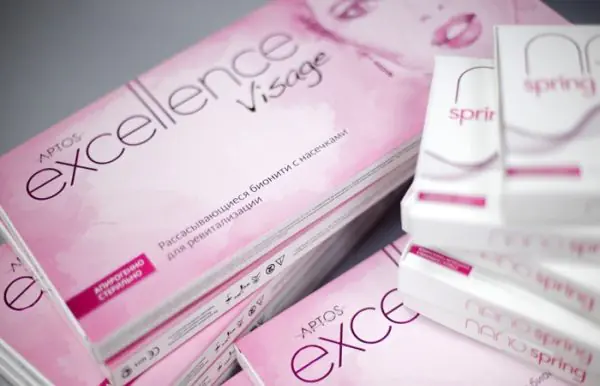
Aptos Excellence threads are very thin and are used for the youngest patients
Preparation for the procedure
The patient should be ready to outline his expectations to the doctor at the first consultation. The second important point that is discussed during the consultation is contraindications. To consent to the procedure, the patient is asked to fill out a questionnaire, where he indicates information about past illnesses and operations, allergic reactions, taking anticoagulants and antiplatelet agents, non-steroidal anti-inflammatory drugs. Based on the results of reviewing this questionnaire and the initial examination, the doctor makes a conclusion about the client’s admission to the procedure.
There are practically no lifestyle restrictions during preparation for the thread lifting procedure. The only thing doctors recommend is not to eat or drink alcohol 2 hours before the procedure. It is also worth limiting the amount of liquid consumed.
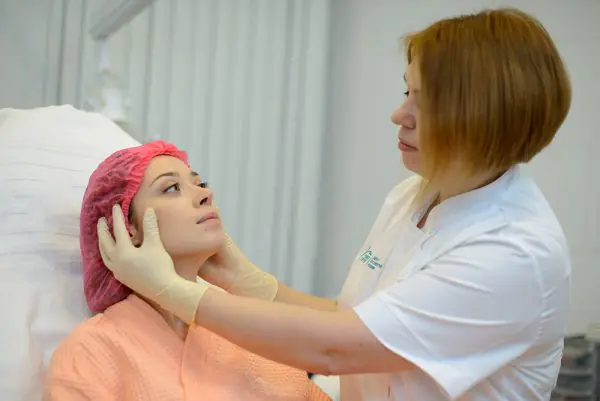
If you can’t decide on a thread lift, visit several clinics, listen to different specialists, this will help you make your choice
How to make reinforcement
Thread lifting is done under local anesthesia - painkillers are administered in the form of injections according to a pre-drawn scheme. This part of the procedure, as patients say, is the most sensitive, but you have to endure it - then it will be easier.
The threads themselves are inserted using a long and flexible cannula needle - to a depth of 3 to 5 mm. If the reinforcement is carried out with smooth threads, after removing the cannula, their ends are fixed with knots; if the threads are notched, they are pulled back a little so that the hooks are tightly fixed in the soft tissues - then no additional fixation is required.
The sensations during installation are reminiscent of... darning. The skin, patients say, feels like a piece of tarpaulin, and it feels like this flap is being trivially darned with thread.
The entire procedure usually takes no more than an hour. At the end, the doctor gives recommendations for the recovery period, which takes on average 1–2 weeks. It is not necessary to spend all this time at home - you can go to work a week after the procedure. Thread lifting leaves swelling and small bruises on the face, which can be easily disguised with foundation. The date of the next procedure is set by the doctor on a personal basis, but not earlier than after 2 months.
Installing Aptos threads - video
What effect will happen after the procedure and when will it appear?
What results can be achieved by reinforcing Aptos threads:
- smoothing wrinkles on the neck;
- removal of nasolabial folds;
- forehead lifting and eyebrow correction;
- correction of lip shape and removal of wrinkles around the mouth;
- correction of the mental area (removal of jowls);
- double chin removal;
- lifting the décolleté area;
- abdominal skin tightening;
- skin tightening in the triceps area and on the inside of the shoulder;
- skin tightening on the inner thighs;
- correction of the area above the knee.
The visible effect is observed 5–6 weeks after installation of the implants.
Aptos threads - results after three weeks - video
Possible complications and how to avoid them
It is not recommended to look in the mirror for the first week after installing the threads, so as not to get scared. Bruises, hemorrhages and swelling of the face - such consequences often occur, and you should not be afraid of them. The swelling subsides quite quickly and damaged blood vessels are restored. Restoring gels and cosmetics can help. Facial expressions, somewhat “inhibited” at first due to anesthesia, also quickly recover. Another thing is that you will then have to control the facial muscles yourself and try to strain them as little as possible - all so that the threads do not move.
What else frightens patients is the feeling of “tightness” of the skin, or overcorrection. Doctors often lift the problem area of skin above its natural position. But the swelling will go away, and with it the tissues will return to their normal position. All these problems do not require medical intervention and go away on their own within a week (often faster) after the procedure.
Rarely, there are other complications that require medical attention:
- depressions and bumps along the reinforced threads - either because the implants have moved from the intended trajectory, or because the tissue on the thread is unevenly distributed. Also, lumps and compactions can form at the needle entry/exit points;
- allergy to anesthetic/suture material that did not go away after taking antihistamines;
- inflammation in the reinforcement area;
- persistent deformation of tissues, which occurs due to the fact that the threads are stretched too tightly;
- thread migration;
- contouring of threads (the tip of the thread or the entire thread may appear).
In difficult cases, the threads are removed. The procedure is safe and painless. Several punctures are made along the installed implant, and through them the thread is cut and removed upward using a needle with a curved tip or a hook.
How is the rehabilitation period going?
After the implants are placed, the patient can leave the clinic - outpatient treatment and doctor's supervision are not required. The most important thing is to strictly follow all recovery recommendations. In the first 5–7 days, you will have to limit your facial expressions, sleep only on your back, eat cold and warm food, and you should also give up hot drinks for a while. Medications (including those for external use) are taken as prescribed by a doctor.
When the swelling and bruising subside (and by the end of the first week they usually disappear), you can talk, smile, eat and drink what you want, but you need to avoid sports and any physical activity, as well as sun and water baths for another week. three.
Reviews of Aptos threads for face lifting with photos
For the first time, I installed threads on the recommendation of a cosmetologist, since no amount of injections could save my tissue ptosis. The condition of the skin will improve, but there will be no shaving, nasolabial folds, etc. I applied 1 pack of Visages to my cheekbones. The result was pleasing: the skin was clearly moisturized, the tear folds were filled and the nasolabial folds were reduced. Honestly, it was scary, especially in the first days, when there was uneven swelling and bruising, and, of course, reviews from particularly panicked clients added fuel to the fire. After a month, I realized that I began to look younger. Six months later I put Elegance on the jaws. The jowls tightened up and after a month it became clear that the oval needed to be tightened 10 years ago. This time, not everything went smoothly. One thread went superficially and was visible. They removed it without any problems in 2 minutes, without pain, bruises or anything else. So don’t panic, don’t go near the mirror for a week and everything will be fine. Savings on mesotherapy and hyaluronic acid, because in the end the threads are cheaper.
Svv54
http://otzovik.com/review_2579018.html
I installed makeup and 2 threads with an offset on each side in the lower part of the face 3 months ago. I was worried about the emerging jowls and the sad horse’s face in general, as my cosmetologist said. I'm 38. Well, what can I say. The procedure itself can be tolerated. The face looks terrible. I wore a mask at home for a week so as not to shock my family. The month's face is scary. It's uncomfortable to go outside. Those who write that they will have beauty in a week, either only do a make-up, or are simply lying. The month is a scary face. For the second month I waited patiently for the promised beauty to arrive. It didn't come. After 2.5 months, I injected filler to somehow disguise the unevenness. Well, it got better.
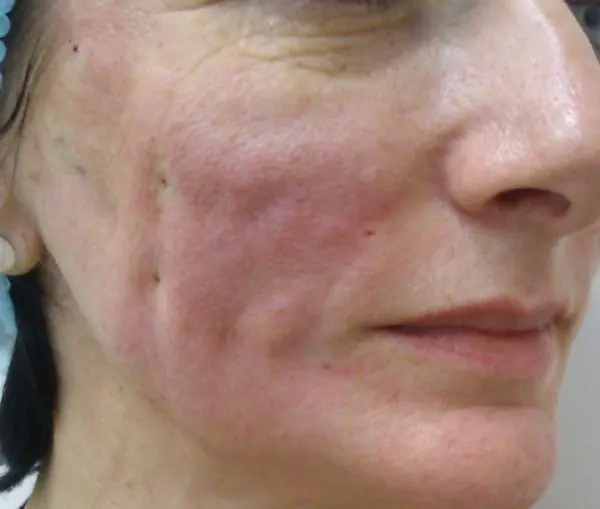
Pits and thickening of the skin after the installation of threads are one of the possible negative consequences of reinforcement; if they appear on the face, you need to consult a doctor
Lera
http://www.woman.ru/beauty/plastic/thread/3959683/9/
In January I installed Aptos threads. After June 2017 I had a not entirely successful blepharoplasty, but this time I approached the choice of a doctor very seriously and responsibly. I read this topic from cover to cover and, based on positive reviews, made my choice - a cosmetologist from St. Petersburg. Because I’m from another city, so of course I wanted to do everything at once, i.e. threads + fillers. But Dmitry explained that with thread lifting, subcutaneous fat tissue moves and fillers cannot be injected at the same time. It was decided to divide the procedures into two stages. First threads, then fillers. As a result, they supplied me with two sets of threads: Excellance Visage and Needle 2G Soft. My face is not simple, not symmetrical, there is very little subcutaneous fat on the right side and Dmitry had to tinker with me. And here the skill and skill of the doctor is very important. Because If installed incorrectly, the threads can contour. The installation was not very pleasant, but tolerable and hardly painful. After upper and lower blepharoplasty under local anesthesia, this procedure seemed like flowers to me. And what is most surprising is that after installation there were no strong painful sensations. The rehabilitation period passed quite unnoticed, although I was mentally preparing for all sorts of inconveniences (difficulty chewing, brushing teeth, etc.). But I had nothing like that. I thought maybe they missed something. Now, after 1.5 months, I am very pleased with the result. Cheekbones appeared, the nasolabial lips smoothed out, and the oval tightened. I really want the results to last longer.
lerlara
https://plastic-surgeon.ru/forum/showthread.php?p=2703626
Aptos threads still remain a very popular procedure. Although many negative reviews indicate that bioreinforcement does not provide the full lifting effect that women expect after any anti-aging procedure.



